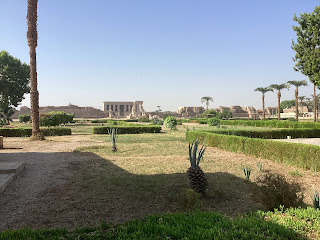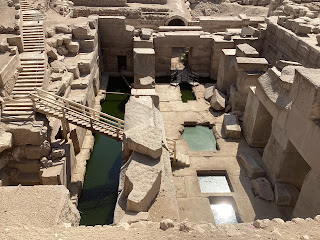Day 19
Remember those old Channel Seven Leyland Brothers specials our parents made us watch when we were kids, and how the program promised lots of interesting destinations, but in reality was just a home movie about driving for hours on end? Well my friends, eleven hours in Zac (“Mal”) Leyland’s kombi van crisscrossing the Egyptian country side in search of more temples has convinced me (though our guide Shenouda (“Mike”) Leyland will try to convince you otherwise), that there is really only one temple in this part of Egypt. It is shaped like a dodecagon (twelve sides), and each side is a separate entrance (sporting its own unique facade, name, and series of “False Doors” which are really hidden connecting entry and exit points), creating the ruse that you are visiting one of many ancient temples in the area, when in fact it is the same temple simply approached from a different angle.
We arrived at the sixth entrance to the Great Dodecagon Temple today which Mike told us is called, the “Dandara” or “Dendera Temple”.
The Temple of Dendera dates back to the Ptolemaic Period, although evidence points to older structures once existing on the site dating as far back as King Pepy I.
Among the temple’s most notable features are the astronomical engravings on its ceiling, including a magnificent calendar, and the proof (an engraving that through a series of alterations bares an uncanny resemblance to a helicopter, tank and submarine), all the nut job conspiracy theorists believe proves aliens built Egypt.
It also boasts the only likenesses of Cleopatra with her son (fathered by Julius Caesar), Caesarian.
The temple complex is quite large (it’s surrounded by a sizable mudbrick wall), boasting a basilica (utilised by Coptic Christians in the region), Sanatorium (consisting of two bath houses), a sacred lake (which was the source of water for sacred rituals and for everyday use), shrines, temples (of which one is dedicated to the birth of Isis), and of course the telltale mix of columns, statues, avenues, and false doors one would expect to find within the walls of the Great Dodecagon Temple.
Mike ensured we had just enough time to walk around and explore a little (but not enough to realise the truth), before Mal suddenly appeared and ushered us into the kombi. The genius to this ruse, is that we never knew where we were headed? Mike and Mal were very clever. One moment we’d be travelling down the highway, then Mal would exit onto a dirt road that seemed to pass through a building site, do a U-turn, drive through someone’s paddock, then down an alleyway, cross a bridge, drive through a town, do another U-turn, drive the wrong way down a one way street, take a sudden left, do another U-turn, and we’d be back on the highway again 10 metres from where we exited.
As we approached the seventh entrance to the Great Dodecagon Temple, Mal made a sudden left turn onto a dirt road (that seemed to pass through yet another building site), and down an alleyway. He stopped the van and Mike got out and went over to an intriguing large wooden door and knocked. Curious, we got out and followed him into a house where we were warmly welcomed and enjoyed a wonderful home cooked lunch. The owner of this house is potentially one of the richest people on earth, for he lives on top of the buried Great Dodecagon Temple’s Gringott’s Bank. Apparently if he attempts to do an “Ocean’s Eleven” inspired heist (and dig a tunnel through his living room floor into one of the vaults), he will be evicted.
Sufficiently fed, watered and noticing the poorly concealed pick axes, shovels and lamps under the rug in the corner, we hopped back in the kombi and returned to the seventh entrance to the Great Dodecagon Temple, which Mike called, “The Great Temple of Abydos”.
The first structure you see is the Temple of Seti I, which is one of the most complete temples in Egypt. The temple is entered through a largely destroyed pylon and two open courtyards, built by Ramses II, (Mr Wim’s favourite Pharaoh), who is depicted on the portico killing Asiatics and worshipping Osiris. Beyond it are two halls and lots of rooms with exquisite decorations and carvings. Of course the telltale mix of columns, statues, shrines, corridors, and false doors one would expect to find within the walls of the Great Dodecagon Temple are also present.
One of the highlights of the temple is the long list of pharaohs (carved on a wall in one of the corridors), which is known as the "Abydos King List", and as an almost complete list of pharaoh names, the Table of Abydos has been called the "Rosetta Stone" of Egyptian archaeology.
Another thing of note is the “Osireion” (a mysterious stone-paved island surrounded by a water basin at the rear of the temple complex), which is closed to anyone (possibly another concealed entrance into the broader Great Dodecagon Temple), who can’t afford the USD$1000 entry fee.
Again Mike ensured we had just enough time to walk around and explore a little (but not enough to realise the truth), before Mal and his kombi, plus a police escort (perhaps we were getting too close to the truth), came trundling towards us to take us back to the hotel.
Mike informed us that our journey home would take three hours (which was okay by us as Mal’s kombi is air conditioned), giving us a chance to relax and people watch. The things that stood out were; the random places you find a speed hump (sometimes on a main road, in a small alley, or on a highway, and for no apparent nor justifiable reason), the number of police checkpoints we had to go through, and the modes of transport people rely on, such as tuk tuks, cars, vans, motor bikes, motorbike-utes, and donkeys. It really was fascinating.








































No comments:
Post a Comment